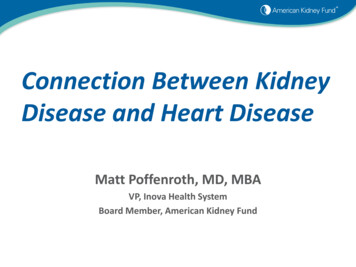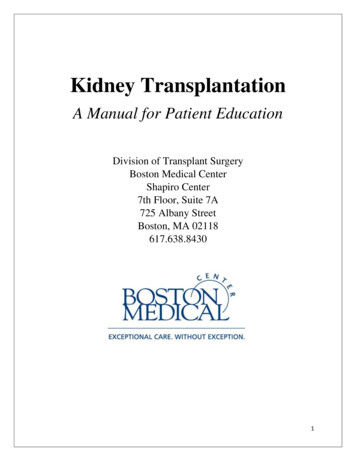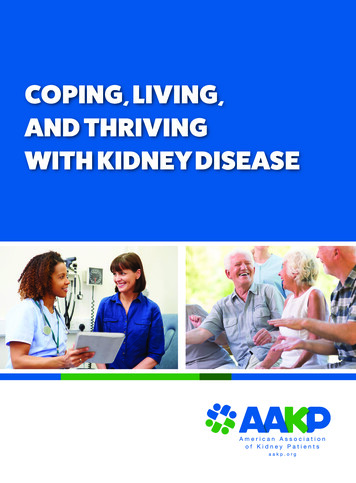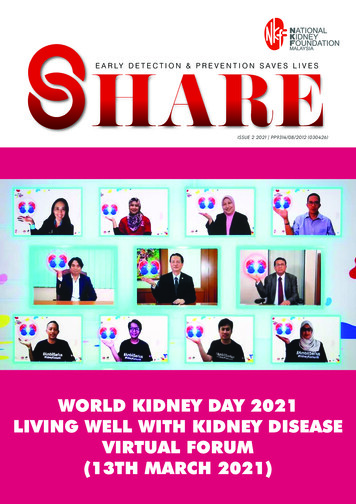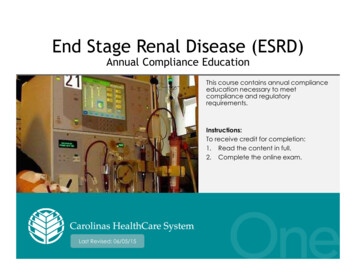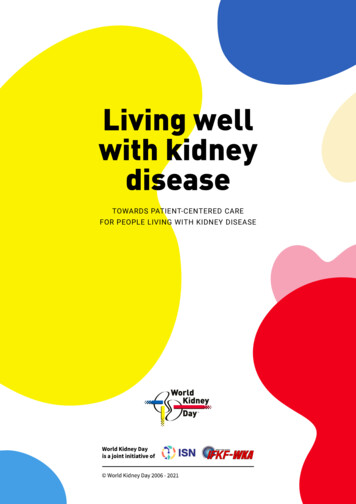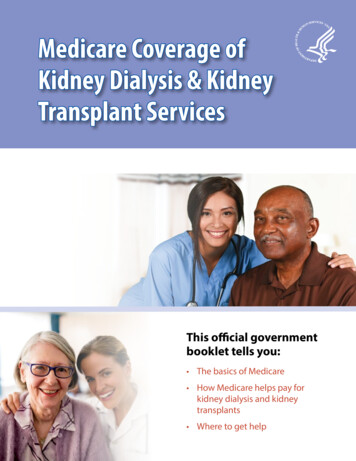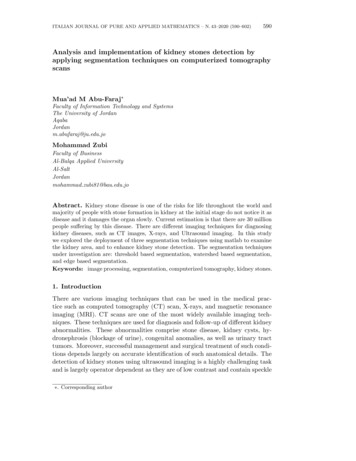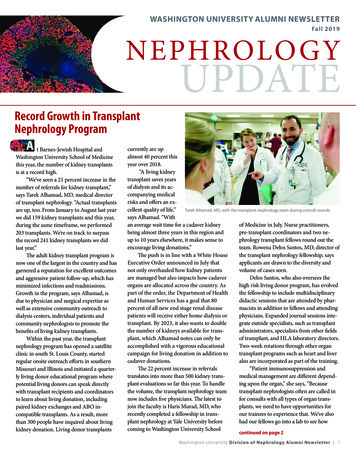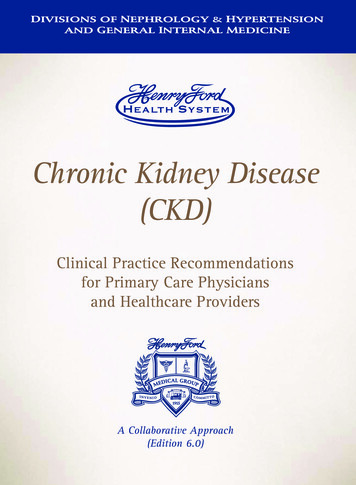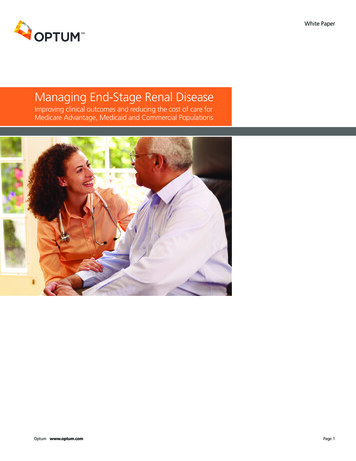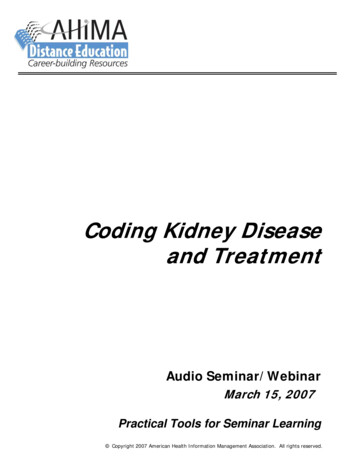
Transcription
Coding Kidney Diseaseand TreatmentAudio Seminar/WebinarMarch 15, 2007Practical Tools for Seminar Learning Copyright 2007 American Health Information Management Association. All rights reserved.
DisclaimerThe American Health Information Management Association makes norepresentation or guarantee with respect to the contents herein andspecifically disclaims any implied guarantee of suitability for any specificpurpose. AHIMA has no liability or responsibility to any person or entitywith respect to any loss or damage caused by the use of this audioseminar, including but not limited to any loss of revenue, interruption ofservice, loss of business, or indirect damages resulting from the use of thisprogram.CPT five digit codes, nomenclature, and other data are copyright 2006American Medical Association. All Rights Reserved. No fee schedules,basic units, relative values or related listings are included in CPT. The AMAassumes no liability for the data contained herein.As a provider of continuing education, the American Health InformationManagement Association (AHIMA) must assure balance, independence,objectivity and scientific rigor in all of its endeavors. AHIMA is solelyresponsible for control of program objectives and content and the selectionof presenters. All speakers and planning committee members are expectedto disclose to the audience:1) any significant financial interest or other relationships with themanufacturer(s) or provider(s) of any commercial product(s) orservices(s) discussed in an educational presentation;2) any significant financial interest or other relationship with anycompanies providing commercial support for the activity; and3) if the presentation will include discussion of investigational orunlabeled uses of a product.The intent of this requirement is not to prevent a speaker with commercialaffiliations from presenting, but rather to provide the participants withinformation from which they may make their own judgments.AHIMA 2007 Audio Seminar Seriesi
FacultyAudrey G. Howard, RHIA,Ms. Howard is a senior consultant with 3M Health Information Systems (HIS),Consulting Services, where she is responsible for performing coding researchand providing support for coding questions. Audrey has over 16 years of HIMexperience working in a variety of functions from coding professional toassistant director of an HIM department. She is also a regular contributor topublications on coding topics.Simone R. Gravesande, RN,Ms. Gravesande is a healthcare consultant for 3M HIS Consulting Services.Simone has ten years of nursing experience, including acute care manager forhemodialysis and apheresis services in a hospital setting where herresponsibilities included providing training to acute and hospital staff. She alsoprovided education to patients and their families to ensure compliance withphysician’s orders.AHIMA 2007 Audio Seminar Seriesii
Table of ContentsDisclaimer . iFaculty .iiObjectives . 1Basic Kidney Information . 1Chronic Kidney Disease. 3NKF Quality Initiative . 4Signs and Symptoms . 5Diagnosis. 6Preventive Treatment . 7Treatment of Kidney Failure . 7Staging Kidney Disease . 8Complications of CKD. 9ICD-9-CM Coding . 9Stages Based on Severity .10Diabetes Related to CKD .11Kidney Transplant Status .11Azotemia .12Polling Question #1 .12Chronic Renal Insufficiency .13Hypertensive Kidney Disease.13Polling Question #2 .16CKD/CRF Decision Tree.16Acute Renal Failure .17Symptoms .18Treatment .18Acute vs. Chronic Chart.19Coding ARF.19Fluid Overload.21Congestive Heart Failure .21ARF and Hypertension .22Azotemia .22Acute on Chronic Renal Failure .23Acute Renal Insufficiency .23Poll #3 .24ARF Decision Tree .25Treatment Options .25Coding Treatment Options- ICD-9-CM and CPT .26Hemodialysis Access .27Coding Access Options.28Peritoneal Dialysis .31Coding Peritoneal Dialysis .32Kidney Transplantation .33Coding Kidney Transplant.34Resources .36Appendix .39CKD/CRF Decision Tree.40ARF Decision Tree .41CE Certificate InstructionsAHIMA 2007 Audio Seminar Series
Coding Kidney Disease and TreatmentNotes/Comments/QuestionsObjectives Review clinical knowledge of kidney diseaseincluding: Chronic kidney disease Chronic renal insufficiency Hypertensive kidney disease Acute renal failure Acute renal insufficiency Discuss complications of kidney disease Discuss treatment options for kidney disease Discuss ICD-9-CM and CPT coding of diagnosesand procedures for kidney disease1Basic Kidney Information Part of the urinary system Pair of bean-shaped organs locatedin the back of the abdomen belowthe rib cage Size of a fist Functions: Filters blood through nephrons Removes waste products and extra water Regulates chemicals in the blood such as sodium,potassium, phosphorus and calcium Produces hormones that help regulate blood pressure,make red blood cells and promote strong bones2AHIMA 2007 Audio Seminar SeriesCPT Codes Copyright 2006 by AMA. All Rights Reserved1
Coding Kidney Disease and TreatmentNotes/Comments/QuestionsCross Section of Kidney3Kidney Disease Results from damage to the nephronsWaste builds up in the blood and damagesthe bodyOccurs gradually over years in bothkidneysSudden onset from acuteprocess or injuryLeading causes: DiabetesHigh blood pressureHeart diseaseHeredityAHIMA 2007 Audio Seminar SeriesCPT Codes Copyright 2006 by AMA. All Rights Reserved42
Coding Kidney Disease and TreatmentNotes/Comments/QuestionsChronic Kidney Disease Permanent loss of kidney functionUnable to properly remove waste and extra waterfrom bloodDefined according to the presence or absence ofkidney damage and the level of kidney functionbased on the glomerular filtration rate (GFR)GRF is calculated from the results of the patient’sblood creatinine test, patient’s age, race, genderand other factors and is the best test to measurethe level of kidney function Creatinine is a waste product in the blood created by thenormal breakdown of muscle cells during activity Creatinine builds up in the blood when kidneys are notworking well5Chronic Kidney Disease National Kidney Foundation defines CKDas follows: “Kidney damage for three or more months, asdefined by structural or functional abnormalitiesof the kidney, with or without decreased GFR,manifested by pathologic abnormalities ormarkers of kidney damage, includingabnormalities in the composition of the blood orurine or abnormalities in imaging tests”GFR 60 mL per minute per 1.73 m² for threemonths or more, with or without kidney damage6AHIMA 2007 Audio Seminar SeriesCPT Codes Copyright 2006 by AMA. All Rights Reserved3
Coding Kidney Disease and TreatmentNotes/Comments/QuestionsChronic Kidney Disease Facts about Chronic Kidney Disease (CKD): 20 million Americans have CKD 1 in 9 adults Early detection can help prevent the progression of kidneydisease to kidney failure Glomerular filtration rate (GFR) is the best estimate ofkidney function Hypertension causes CKD and CKD causes hypertension Persistent proteinuria means CKD High risk groups include those with diabetes, hypertension,and family history of kidney disease African Americans, Hispanics, Pacific Islanders, NativeAmericans and Seniors are at increased risk Three simple tests can detect CKD: blood pressure,urine and serum creatinine Information obtained from National Kidney Foundation(www.kidney.org)7NKF Quality Initiative KDOQI (Kidney Disease Outcomes Quality Initiative) Address CKD and treatment modalities Published new stages for kidney disease in May2006 Recommended defining stages of kidney diseaseto facilitate clinical practice guidelines,performance measurements, evaluation of QI,and disease management Classification of stages of CKD goals Provide estimate of prevalence by stage Develop clinical action plan for evaluation andmanagement for each stage Identify individuals at increased risk for developing CKDAHIMA 2007 Audio Seminar SeriesCPT Codes Copyright 2006 by AMA. All Rights Reserved84
Coding Kidney Disease and TreatmentNotes/Comments/QuestionsNKF Quality Initiative KDOQI continued Evaluation should be base on Type of kidney disease Co morbid conditions Severity of illness determined by kidney function Complications Risk for loss of kidney Risk for cardiovascular disease Information obtained from NKF KDOQI Guidelines9Chronic Kidney Disease Early signs andsymptoms in earlystages of CKD: Fatigue Nausea and vomiting Weight loss (unintentional) Frequent hiccups Headache Pruritus (general itching) MalaiseA patient may not developsymptoms until the kidneyfunction has decreased to lessthan 25% of normal Later signs andsymptoms of CKD: Trouble concentrating,lethargy Poor appetite Trouble sleeping Nighttime musclecramping Swollen feet and ankles Excessive thirst Dry, itchy skin Increase in urination,especially at night Oliguria Seizures Uremic frost (white crystaldeposits on skin)10AHIMA 2007 Audio Seminar SeriesCPT Codes Copyright 2006 by AMA. All Rights Reserved5
Coding Kidney Disease and TreatmentNotes/Comments/QuestionsChronic Kidney Disease Can occur at any ageCauses of chronic kidney disease: Diabetes, uncontrolledHypertension, uncontrolledPolycystic kidney diseaseCongenital malformationsSLERepeated urinary infectionsHIVAN (HIV Associated Nephropathy)IgA Nephropathy11Chronic Kidney Disease Diagnosis: Monitor blood pressure – hypertension may be a signthat kidney damage has occurred GFR – measures how efficiently the kidneys are filteringwaste from the blood Proteinuria (excess protein in urine) can detect akidney problem Protein-to-creatinine (albumin-to-creatinine) ratio – ifratio is greater than 30 milligrams of albumin per 1gram of creatinine, kidneys may be failing to filter outharmful substances MRI, CT scan, ultrasound, or contrast X-ray to detectkidney damage Renal biopsy12AHIMA 2007 Audio Seminar SeriesCPT Codes Copyright 2006 by AMA. All Rights Reserved6
Coding Kidney Disease and TreatmentNotes/Comments/QuestionsChronic Kidney Disease Preventive treatment of chronic kidneydisease: Life style changes: Control blood pressure level (below 130/80 mm Hg) Control blood sugar Control triglyceride and cholesterol levels Control hemoglobin to prevent anemia Balance levels of calcium and phosphorus in blood Maintain proper diet Medications13Chronic Kidney Disease Treatment of kidney failure: Dialysis Hemodialysis– High Flux machine or CRRT toremove toxic waste and excess fluid Peritoneal dialysis Kidney transplant Kidney/Pancreas transplant14AHIMA 2007 Audio Seminar SeriesCPT Codes Copyright 2006 by AMA. All Rights Reserved7
Coding Kidney Disease and TreatmentNotes/Comments/QuestionsMedical RecordPatient with Kidney Failure HTN: Calcium Channel Blockers: Procardia, Cardizem, bidBeta Blockers: Lopressor, Inderal, qidACE Inhibitors: Vasotec, Capoten, bidEdema: Lasix, Bumex, bidHigh Cholesterol: Mevacor, qdVitamin: Nephrocap, Nephro-Vite, Forte, Vitamin B, qdGastroparesis: Reglan, prior to each mealItching: Atarax, Benadryl, Vistaril prnSleep Disorders: Halcion, qhsDepression: Ativan, Xanax, tidOsteoporosis: Calcijex, Zemplar, Hectorol, IV at Dialysis, oralcalcium, tidAnemia: Epogen, Aranesp, Procrit, Ferrlecit, Venofer IV, oral iron,bidIncreased Phosphorous: Basaljel, Phoslo, Renagel with meals, TumsDiet: Low Protein, Low Sodium, Low Potassium, Fluid restrictions15Chronic Kidney DiseaseStageDescriptionGFR(mL/min/1.73m²)Clinical Action Plan*1Slight kidney 90ml/mindamage withnormal orincreased filtrationTreatment of comorbid conditions,interventions to slow diseaseprogression, reduction of risk factorsfor cardiovascular disease2Mild decrease inkidney functionEstimation of disease progression3Moderate decrease 30-59ml/minin kidney functionEvaluation and treatment of diseasecomplications4Severe decrease inkidney function15-29ml/minPreparation for kidney replacementtherapy (dialysis, transplantation)5Kidney failure;requiring dialysisor transplantation 15Kidney replacement therapy ifuremia is present60-89ml/min*Includes action plan from preceding stages16AHIMA 2007 Audio Seminar SeriesCPT Codes Copyright 2006 by AMA. All Rights Reserved8
Coding Kidney Disease and TreatmentNotes/Comments/QuestionsComplications ofChronic Kidney Disease Congestive heart failureHypertensionChronic blood loss anemiaElectrolyte imbalances (hyperkalemia,hypercalcemia, hyperphosphatasemia)Metabolic acidosis and alkalosisPericarditisInfertility, ImpotenceInfections (due to vascular access andimmunosuppressive host)EncephalopathyIncreased risk for hepatitis B & CNeuropathyHyperparathyroidismBone disease and calcificationsClotted vascular access17ICD-9-CM CodingChronic Kidney Disease 585.1, Chronic kidney disease, Stage I 585.2, Chronic kidney disease, Stage II (mild) 585.3, Chronic kidney disease, Stage III(moderate) 585.4, Chronic kidney disease, Stage IV (severe) 585.5, Chronic kidney disease, Stage V Excludes: Chronic kidney disease, stage V requiringchronic dialysis (585.6) 585.6, End stage renal disease Chronic kidney disease requiring chronic dialysis18AHIMA 2007 Audio Seminar SeriesCPT Codes Copyright 2006 by AMA. All Rights Reserved9
Coding Kidney Disease and TreatmentNotes/Comments/QuestionsICD-9-CM CodingChronic Kidney Disease 585.9, Chronic kidney disease, unspecified Chronic renal disease Chronic renal failure NOS Chronic renal insufficiency– Note: Acute renal insufficiency remains classified to code593.9 ICD-9-CM code assignment is based on physiciandocumentation of the specific stage and not theGFR19Chronic Kidney Disease Stages based on severity of CKD: Stage II equates to mild CKD (585.2) Stage III equates to moderate CKD(585.3) Stage IV equates to severe CKD (585.4) End stage renal disease (ESRD) (585.6) If the physician documents both astage of CKD and ESRD, only assigncode 585.6AHA Coding Clinic for ICD-9-CM, 2006, 4Q, p179AHIMA 2007 Audio Seminar SeriesCPT Codes Copyright 2006 by AMA. All Rights Reserved2010
Coding Kidney Disease and TreatmentNotes/Comments/QuestionsChronic Kidney Disease Diabetes related to CKD 250.4x 585.x Sequence the code from category 250 before the codes forthe associated conditions Documentation must link the diabetes to the condition suchas diabetic nephropathy or nephropathy due to diabetes Anemia in chronic kidney disease 285.21 585.x Sequencing depends on the circumstances of admission The physician has to explicitly state a cause and effectrelationship between the anemia and the CKD21Chronic Kidney Disease Kidney transplant status The presence of CKD after a kidney transplant does notindicate a transplant complication since the transplantmay not fully restore kidney function Appropriate to assign code V42.0, Kidney replaced bytransplant, with a code from category 585 if no transplantcomplication is documented If a transplant complication (such as transplant failure orrejection) is documented, assign code 996.81,Complications of transplanted kidney Query the physician for clarification if the documentationis unclear regarding the presence of a transplantcomplication22AHIMA 2007 Audio Seminar SeriesCPT Codes Copyright 2006 by AMA. All Rights Reserved11
Coding Kidney Disease and TreatmentNotes/Comments/QuestionsChronic Kidney Disease Azotemia If physician documents pre-renal failure or pre-renalazotemia, assign code 788.9, Symptom involving urinarysystem (DRG 325) Code 788.9 also includes extrarenal, prerenal, and postrenalazotemia If physician documents azotemia, assign code 790.6,Abnormal blood chemistry (DRG 463) Appropriate to clarify with physician if patient presentswith signs and symptoms of chronic renal failure For example: Azotemia is documented in the ER record and history andphysical. The patient presented with an elevated BUN andcreatinine, anemia, nausea, and vomiting. Please clarify ifthe patient has chronic renal failure.23Poll #1The physician documents that the patient isadmitted with chronic renal failure. The H&Pnotes the patient has been on chronic dialysisfor 5 years.What code should be assigned on this case?*1*2*3*4Kidney disease (593.9)Acute renal failure (584.9)Chronic renal failure (585.9)End stage renal disease (585.6)24AHIMA 2007 Audio Seminar SeriesCPT Codes Copyright 2006 by AMA. All Rights Reserved12
Coding Kidney Disease and TreatmentNotes/Comments/QuestionsChronic Renal Insufficiency A condition in which the kidneys gradually losetheir ability to remove waste and extra fluid fromthe body or to regulate the amounts of vitaminsand minerals, such as calcium and iron, involved inthe growth processSlow, gradual destruction of the filtering capacityof the kidneysSome physicians may use the terms chronic renalinsufficiency (CRI) and chronic renal failure (CRF)interchangeablyICD-9-CM code: 585.925Hypertensive Kidney Disease Occurs in patients who have undetected,untreated, or poorly controlled hypertensionHypertension is the second leading cause ofkidney failureHypertension makes the heart work harderand can damage the small blood vessels inthe bodyDamaged arteries result in insufficient bloodflow to organs including the kidneyLeads to kidney damage callednephrosclerosisAHIMA 2007 Audio Seminar SeriesCPT Codes Copyright 2006 by AMA. All Rights Reserved2613
Coding Kidney Disease and TreatmentNotes/Comments/QuestionsHypertensive Kidney Disease Instructional note under category 403 states,“Includes: Any condition classifiable to 585, 586,587 with any condition classifiable to 401”New instructional note added under category 585which states, “Code first hypertensive chronickidney disease, if applicable, (403.00-403.91,404.00-404.93)”Instructional note located under category 586states “Excludes: with any condition classifiableto 401 (403.0-403.9 with fifth-digit 1)”Instructional note under category 587 states“Excludes: with hypertension (403.00-403.91)”27Hypertensive Kidney Disease Category 403, Hypertensive chronic kidney disease (DRGs 315and 316): Fifth digit subclassification “0” states “with chronic kidney diseasestage I through stage IV, or unspecified” Instructional note states “Use additional code to identify the stage ofchronic kidney disease (585.1-585.4, 585.9)” Fifth digit subclassification “1” states “with chronic kidney diseasestage V or end stage renal disease” Instructional note states “Use additional code to identify the stage ofchronic kidney disease (585.5, 585.6)” The following codes were removed from DRGs 331, 332, and333 and added to DRGs 315 and 316 due to code title revisions(effective 10/1/06): 403.00, Hypertensive chronic kidney disease, malignant, withchronic kidney disease stage I through stage IV, or unspecified 403.10, Hypertensive chronic kidney disease, benign, with chronickidney disease stage I thought stage IV, or unspecified 403.90, Hypertensive chronic kidney disease, unspecified, with28chronic kidney disease stage I through stage IV, or unspecifiedAHIMA 2007 Audio Seminar SeriesCPT Codes Copyright 2006 by AMA. All Rights Reserved14
Coding Kidney Disease and TreatmentNotes/Comments/QuestionsHypertensive Kidney DiseaseCategory 404, Hypertensive heart and chronic kidneydisease: 0 – without heart failure and with chronic kidney diseasestage I through stage IV, or unspecified (goes to MDC 5; DRG134) Use additional code to identify the stage of chronickidney disease (585.1-585.4, 585.9) 1 – with heart failure and with chronic kidney disease stage Ithrough stage IV, or unspecified (goes to MDC 5; DRG 127) Use additional code to identify the stage of chronickidney disease (585.1-585.4, 585.9) 2 – without heart failure and with chronic kidney disease stageV or end stage renal disease (goes to MDC 11; DRG 316) Use additional code to identify the stage of chronickidney disease (585.5, 585.6) 3 – with heart failure and chronic kidney disease stage V orend stage renal disease (goes to MDC 5; DRG 127) Use additional code to identify the stage of chronickidney disease (585.5, 585.6)29Hypertensive Kidney Disease Assume a cause and effect link between the hypertensionand CKD unless the physician specifically documents theCKD is not due to hypertensionPhysician documentation of CKD and hypertension isclassified to a code from category 403 and category 585 Examples: End stage renal disease and hypertension 403.91 585.6 Chronic renal insufficiency and hypertension 403.90 585.9 Assign a code from category 404 if the documentationsupports hypertensive heart disease and hypertensivechronic kidney disease Do not assume a cause and effect relationship betweenheart disease and the hypertension even if CKD is presentAHA Coding Clinic for ICD-9-CM, 2006, 4Q, p 172-17430AHIMA 2007 Audio Seminar SeriesCPT Codes Copyright 2006 by AMA. All Rights Reserved15
Coding Kidney Disease and TreatmentPollNotes/Comments/QuestionsA patient is admitted with pneumonia. In the past medicalhistory section of the H&P, the physician documents thepatient has CHF, ESRD and hypertension. The patient is ondialysis on Monday, Wednesday and Friday. The patientreceives lasix during the hospitalization.What codes should be assigned as secondary diagnoses?#2*1 Congestive heart failure (428.0) and hypertensive chronickidney disease with chronic kidney disease stage V or endstage renal disease (403.91)*2 Hypertensive heart and chronic kidney disease with heartfailure and chronic kidney disease stage V or end stage renaldisease (404.93), congestive heart failure (428.0)and ESRD (585.6)*3 Congestive heart failure (428.0), hypertensive chronic kidneydisease with chronic kidney disease stage V orend stage renal disease (403.91) and ESRD (585.6)*4 Congestive heart failure (428.0), ESRD (585.6),and hypertension (401.9)31CRF 2o Nephrosclerosis*Coding Clinic, 1985, N/D, p. 15403.9x (DRG 316)CRF 2o Gout274.89 585.x (DRGs244/245)o CRF 2 Gout Nephropathy withuremia*Coding Clinic, 1985, N/D, p5CRF 2o Diabetes*Coding Clinic, 1991, 3Q, p8 CRF 2o RF)DecisionTree274.10 (Gouty nephropathy) 585.x (DRGs 331/332/333)250.4x (Diabetes) 585.x(DRGs 331/332/333)710.0 585 .x(DRGs 240/241)276.6 (DRGs 296/297/298)Resulting in volume overload428.0 (DRG 127)After renal transplant –complication of transplant*Coding Clinic, 1998, 3Q, p6996.81 585.x (DRGs331/332/333)Admit with infection of peritonealdialysis catheter*Coding Clinic, 1998, 4Q, p. 54996.68 (DRGs 452/453)Fluid Overload not caused by CHF orESRDwith CHF*Coding Clinic, 1996, 3Q, p. 9Admit solely for dialysisV56.0 (DRG 317)Admit for replacement of peritonealdialysis cath*Coding Clinic, 1998, 4Q, p55V56.2 (DRG 317)Prerenal/postrenal/extrarenal azotemia without mentionof CRF*Coding Clinic, 1988, 4Q pp1-3788.9 (DRGs 325/326/327)Clarify with physician if CRFpresentAzotemia unspecified without mention ofCRF*Coding Clinic, 1988, 4Q, pp1-3790.6 (DRGs 463/464)Clarify with physician if CRFpresentChronic renal insufficiency585.9 (DRG 316)Clarify with physician specifiedstage of CKD present32(see Appendix for full page version of CKD Decision Tree)AHIMA 2007 Audio Seminar SeriesCPT Codes Copyright 2006 by AMA. All Rights Reserved16
Coding Kidney Disease and TreatmentNotes/Comments/QuestionsAcute Renal Failure Sudden loss of kidney function that occurs whenthe kidneys stop filtering waste products from thebloodAccumulation of metabolic waste products, suchas ureaDefined as the significant ( 50%) decrease inglomerular filtration rate (GFR) over a period ofhours to days, with an accompanyingaccumulation of nitrogenous wastes in the bodyResults from: Drastic drop in blood pressure that prevents enoughblood from reaching the kidneys Blockage from the blood vessels leading to the kidneys Obstructed urine flow after it leaves the kidneys33Acute Renal Failure Common causes: Blood loss after a complicatedsurgery or severe injury Dehydration Shock Heat stroke Hydronephrosis Nephritis Hemolytic uremic syndrome (HUS) Injuries to the kidneys Toxins Goodpasture Syndrome Thrombotic thrombocytopenicpurpura (TTP) Kidney stones, tumors, or enlargedprostate that cause obstruction Post-op (CABG, cardiac cath) Infectious process (sepsis) Poisonings (antifreeze, drugoverdose) Rhabdomyolysis Medications: Contrast agents used in x-ray tests Non steroidal anti-inflammatorydrugs (NSAIDs) Antibiotics such as gentamicin,neomycin, or streptomycin34AHIMA 2007 Audio Seminar SeriesCPT Codes Copyright 2006 by AMA. All Rights Reserved17
Coding Kidney Disease and TreatmentNotes/Comments/QuestionsAcute Renal Failure Symptoms depend on the severity of kidneyfailure, the rate of progression, and itsunderlying causeCommon signs and symptoms: Decreased urine outputIncrease in creatinine levelIncrease in blood urea nitrogen (BUN) levelBUN:creatinine ratio may be 20 in pre-renal failureElectrolyte imbalances (acidosis, hyperkalemia,hyponatremia)Skin rashConfusionSeizuresComa35Acute Renal Failure Treatment: Treat underlying cause Restrict water intake Modify diet to include high carbohydrate, lowprotein and low potassium Dialysis if kidney failure is severe Prevent further damage to other organs Kidney transplantation if kidneys were badlydamaged36AHIMA 2007 Audio Seminar SeriesCPT Codes Copyright 2006 by AMA. All Rights Reserved18
Coding Kidney Disease and TreatmentNotes/Comments/QuestionsAcute Renal Failurevs. Chronic Renal hronicSudden rapid onset ofSlow progressive loss ofdecreasing renal function renal function over aper
Evaluation and treatment of disease complications Moderate decrease in kidney function 3 Mild decrease in Estimation of disease progression kidney function 2 Treatment of comorbid conditions, interventions to slow disease progression, reduction of risk factors for cardiovascular disease Slight kidney damage with normal or increased filtration 1
